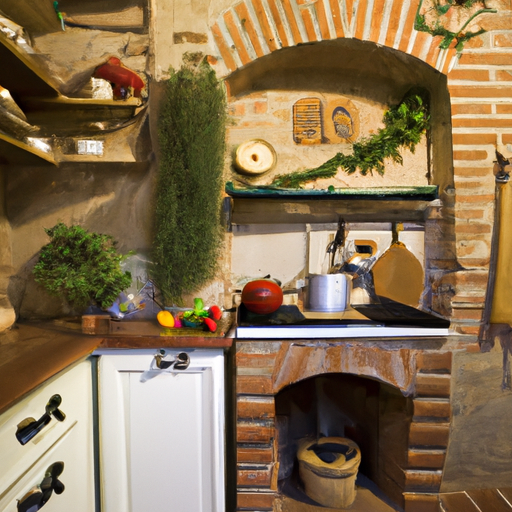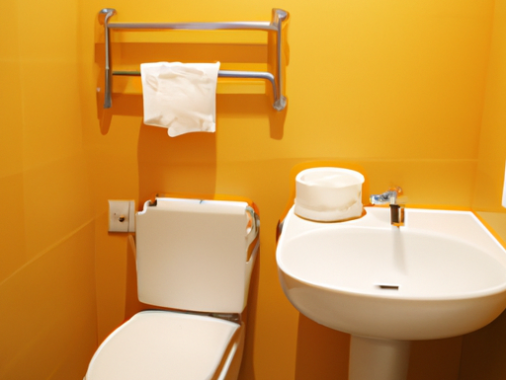-
Table of Contents
- Introduction
- Exploring the History of Italian Kitchen Design
- The Essential Ingredients of an Authentic Italian Kitchen
- How to Create a Rustic Italian Kitchen
- The Benefits of Investing in Quality Italian Kitchen Appliances
- The Art of Italian Cooking: Tips and Techniques for the Home Chef
- The Best Italian Kitchen Gadgets for Every Home Cook
- The Benefits of Incorporating Italian Kitchen Design into Your Home
- Q&A
- Conclusion
Introduction
Italian kitchens are renowned for their warmth and hospitality. They are the heart of the home, where family and friends gather to share meals and stories. The Italian kitchen is a place of comfort and joy, where the aromas of freshly cooked food fill the air. From the classic flavors of the Mediterranean to the modern twists of contemporary Italian cuisine, the Italian kitchen is a place of culinary exploration and discovery. Whether you’re a novice cook or a seasoned chef, the Italian kitchen is a place to explore and create delicious dishes.
Exploring the History of Italian Kitchen Design
The Italian kitchen has a long and storied history, with its design evolving over the centuries to reflect the changing needs of the Italian people. From the traditional rustic kitchens of the Middle Ages to the modern, sleek designs of today, Italian kitchen design has always been a reflection of the culture and values of the Italian people.
In the Middle Ages, Italian kitchens were typically rustic and simple, with a large fireplace as the main source of heat and light. The kitchen was often the center of the home, and the hearth was the focal point of the room. This design was functional and practical, and it allowed for the preparation of large meals for the family.
During the Renaissance, Italian kitchen design began to change. The fireplace was still the main source of heat and light, but the kitchen was now more ornate and luxurious. The walls were often decorated with frescoes and tapestries, and the furniture was more elaborate. This design was meant to reflect the wealth and status of the family.
In the 19th century, Italian kitchen design began to move away from the ornate designs of the Renaissance. The focus shifted to practicality and efficiency, with the introduction of new appliances such as stoves and refrigerators. This allowed for the preparation of larger meals and for the storage of food. The kitchen was now a place for both work and leisure, and it was often decorated with bright colors and patterns.
Today, Italian kitchen design is a mix of traditional and modern elements. The focus is still on practicality and efficiency, but the design is now more stylish and contemporary. The kitchen is often the center of the home, and it is often decorated with modern appliances and materials. The design is meant to reflect the values of the Italian people, while still being functional and practical.
No matter what era it is, Italian kitchen design has always been a reflection of the culture and values of the Italian people. From the rustic kitchens of the Middle Ages to the modern, sleek designs of today, Italian kitchen design has always been a reflection of the culture and values of the Italian people.
The Essential Ingredients of an Authentic Italian Kitchen
An authentic Italian kitchen is a place of warmth, comfort, and deliciousness. It is a place where family and friends gather to share stories, laughter, and of course, food. To create an Italian kitchen, there are certain essential ingredients that must be included.
First and foremost, an Italian kitchen must have a good selection of fresh ingredients. This includes a variety of vegetables, fruits, herbs, and spices. Quality olive oil, garlic, and Parmesan cheese are also essential.
Second, an Italian kitchen must have the right tools. This includes a good set of knives, a cutting board, a mortar and pestle, and a variety of pots and pans. A pasta machine is also a great addition for making fresh pasta.
Third, an Italian kitchen must have the right atmosphere. This includes a warm and inviting atmosphere with plenty of natural light. A good selection of Italian music playing in the background can also help to create a cozy atmosphere.
Finally, an Italian kitchen must have the right recipes. This includes classic Italian dishes such as pasta, pizza, risotto, and tiramisu. Having a good selection of Italian cookbooks is also a great way to find new recipes to try.
By including these essential ingredients, you can create an authentic Italian kitchen that will be the perfect place to share meals with family and friends.
How to Create a Rustic Italian Kitchen
Creating a rustic Italian kitchen is a great way to bring a touch of the Mediterranean into your home. With the right materials and design elements, you can create a space that is both inviting and functional. Here are some tips for creating a rustic Italian kitchen.
1. Choose natural materials. Natural materials such as wood, stone, and terracotta are essential for creating a rustic Italian kitchen. Choose materials that are durable and easy to maintain, such as hardwood floors, stone countertops, and terracotta tiles.
2. Incorporate warm colors. Warm colors such as red, orange, and yellow are essential for creating a rustic Italian kitchen. Choose colors that evoke the warmth of the Mediterranean, such as terracotta, olive green, and yellow ochre.
3. Add texture. Textured materials such as wood, stone, and terracotta add depth and interest to a rustic Italian kitchen. Choose materials with a rough, natural texture, such as distressed wood, rough stone, and terracotta tiles.
4. Incorporate rustic elements. Rustic elements such as exposed beams, distressed furniture, and wrought iron accents add a sense of history and charm to a rustic Italian kitchen. Choose pieces that are simple and timeless, such as a wooden table and chairs, a wrought iron chandelier, and a stone fireplace.
5. Accessorize with Italian accents. Accessories such as Italian pottery, copper cookware, and colorful textiles add a touch of Italian flair to a rustic Italian kitchen. Choose pieces that are both functional and decorative, such as a copper pot rack, a terracotta planter, and a colorful tablecloth.
By following these tips, you can create a rustic Italian kitchen that is both inviting and functional. With the right materials and design elements, you can create a space that is both beautiful and practical.
The Benefits of Investing in Quality Italian Kitchen Appliances
Investing in quality Italian kitchen appliances is a wise decision for any homeowner. Italian kitchen appliances are renowned for their superior craftsmanship, innovative design, and long-lasting durability. From refrigerators and ovens to dishwashers and coffee makers, Italian kitchen appliances offer a range of benefits that make them a worthwhile investment.
First and foremost, Italian kitchen appliances are renowned for their superior craftsmanship. Italian manufacturers use only the highest quality materials and components to ensure that their products are built to last. This attention to detail and commitment to excellence is evident in the sleek, modern designs of Italian kitchen appliances. From the stainless steel finish of a refrigerator to the sleek lines of a dishwasher, Italian kitchen appliances are designed to be both aesthetically pleasing and highly functional.
In addition to their superior craftsmanship, Italian kitchen appliances are also known for their innovative design. Italian manufacturers are constantly pushing the boundaries of kitchen appliance design, introducing new features and technologies that make cooking and cleaning easier and more efficient. From induction cooktops to energy-efficient refrigerators, Italian kitchen appliances are designed to make life in the kitchen more enjoyable.
Finally, Italian kitchen appliances are renowned for their long-lasting durability. Italian manufacturers use only the highest quality materials and components to ensure that their products are built to last. This commitment to quality ensures that Italian kitchen appliances will stand the test of time, providing years of reliable performance.
In conclusion, investing in quality Italian kitchen appliances is a wise decision for any homeowner. Italian kitchen appliances are renowned for their superior craftsmanship, innovative design, and long-lasting durability. From refrigerators and ovens to dishwashers and coffee makers, Italian kitchen appliances offer a range of benefits that make them a worthwhile investment.
The Art of Italian Cooking: Tips and Techniques for the Home Chef
The art of Italian cooking is a timeless tradition that has been passed down through generations. As a home chef, you can bring the flavors of Italy into your own kitchen with a few simple tips and techniques.
First, it is important to understand the basics of Italian cuisine. Italian cooking is all about fresh, seasonal ingredients. When selecting ingredients, look for the freshest and highest quality items available. This will ensure that your dishes are full of flavor and texture.
When it comes to cooking techniques, Italian cuisine relies heavily on the use of herbs and spices. Herbs such as basil, oregano, and rosemary are essential for adding flavor to dishes. Spices such as garlic, red pepper flakes, and black pepper can also be used to add depth and complexity to dishes.
When it comes to pasta, it is important to use the right type of pasta for the dish. Different types of pasta require different cooking times and techniques. For example, long pasta such as spaghetti or linguine should be cooked al dente, while short pasta such as penne or rigatoni should be cooked until just tender.
Finally, it is important to remember that Italian cooking is all about balance. When creating a dish, it is important to consider the flavors of each ingredient and how they will work together. For example, a dish with a tomato-based sauce should be balanced with herbs and spices, while a dish with a cream-based sauce should be balanced with vegetables and cheese.
By following these tips and techniques, you can create delicious Italian dishes in your own home. With a little practice and patience, you can become an expert Italian chef in no time.
The Best Italian Kitchen Gadgets for Every Home Cook
Italian cuisine is renowned for its delicious flavors and fresh ingredients. As such, having the right kitchen gadgets can make all the difference when it comes to creating delicious Italian dishes. Whether you’re a novice or an experienced home cook, here are the best Italian kitchen gadgets for every home cook.
1. Pasta Maker: A pasta maker is an essential tool for any Italian kitchen. It allows you to make fresh pasta quickly and easily, and you can experiment with different shapes and sizes.
2. Pizza Stone: A pizza stone is a must-have for any Italian kitchen. It helps to create a crispy, crunchy crust and ensures that your pizza is cooked evenly.
3. Mortar and Pestle: A mortar and pestle is a great tool for crushing and grinding herbs and spices. This is essential for creating flavorful Italian dishes.
4. Olive Oil Sprayer: An olive oil sprayer is a great way to add flavor to your dishes without adding too much fat. It’s also a great way to control the amount of oil you use.
5. Cheese Grater: A cheese grater is a must-have for any Italian kitchen. It’s perfect for grating hard cheeses like Parmesan and Pecorino.
6. Garlic Press: A garlic press is a great way to quickly and easily mince garlic. It’s also great for adding flavor to sauces and dressings.
7. Tomato Slicer: A tomato slicer is a great tool for quickly and easily slicing tomatoes. It’s perfect for making bruschetta or topping pizzas.
8. Ravioli Maker: A ravioli maker is a great way to make homemade ravioli quickly and easily. It’s perfect for making delicious Italian dishes.
These are just a few of the best Italian kitchen gadgets for every home cook. With these tools, you’ll be able to create delicious Italian dishes in no time. Buon appetito!
The Benefits of Incorporating Italian Kitchen Design into Your Home
Italian kitchen design is a popular choice for many homeowners looking to create a unique and stylish kitchen. Incorporating Italian kitchen design into your home can bring a number of benefits, from increased functionality to a more aesthetically pleasing space.
One of the main benefits of Italian kitchen design is its focus on functionality. Italian kitchen design is known for its efficient use of space, with cabinets and appliances arranged in a way that maximizes storage and counter space. This makes it easier to keep your kitchen organized and clutter-free, while also making it easier to prepare meals. Additionally, Italian kitchen design often includes features such as built-in cutting boards and pull-out shelves, which can make it easier to access items stored in cabinets and drawers.
Italian kitchen design is also known for its aesthetic appeal. Italian kitchen design often features bold colors and patterns, as well as unique materials such as marble and granite. This can help to create a visually stunning kitchen that stands out from the rest of your home. Additionally, Italian kitchen design often includes unique details such as ornate tile work and decorative hardware, which can add a touch of elegance to your kitchen.
Finally, Italian kitchen design is known for its durability. Italian kitchen design often features high-quality materials that are designed to last for years. This means that you can enjoy your Italian kitchen design for many years to come, without having to worry about replacing it anytime soon.
Incorporating Italian kitchen design into your home can bring a number of benefits, from increased functionality to a more aesthetically pleasing space. With its focus on functionality, bold colors and patterns, and durable materials, Italian kitchen design can help to create a unique and stylish kitchen that you can enjoy for years to come.
Q&A
1. What is the traditional style of Italian kitchen design?
The traditional style of Italian kitchen design is characterized by warm colors, natural materials, and an emphasis on functionality. Common features include open shelving, stone countertops, and rustic wood accents.
2. What are some common materials used in Italian kitchens?
Common materials used in Italian kitchens include stone, marble, wood, and ceramic tile. These materials are often used to create a rustic, natural look.
3. What are some popular Italian kitchen appliances?
Popular Italian kitchen appliances include espresso machines, pasta makers, and pizza ovens. These appliances are designed to make cooking Italian food easier and more enjoyable.
4. What are some traditional Italian kitchen accessories?
Traditional Italian kitchen accessories include copper pots and pans, ceramic serving dishes, and colorful glassware. These items are often used to add a touch of style and sophistication to the kitchen.
5. What are some popular Italian kitchen colors?
Popular Italian kitchen colors include warm neutrals such as beige, cream, and taupe. Bright colors such as red, yellow, and blue are also popular.
6. What are some common Italian kitchen layouts?
Common Italian kitchen layouts include the galley kitchen, the U-shaped kitchen, and the L-shaped kitchen. These layouts are designed to maximize space and provide easy access to all areas of the kitchen.
7. What are some popular Italian kitchen styles?
Popular Italian kitchen styles include Tuscan, Mediterranean, and modern. These styles are characterized by warm colors, natural materials, and an emphasis on functionality.
Conclusion
Italian kitchens are a great way to bring a touch of Italian culture and style into your home. They are known for their classic and timeless designs, as well as their use of high-quality materials and craftsmanship. Whether you are looking for a traditional Italian kitchen or a modern take on the classic style, Italian kitchens are sure to bring a unique and beautiful look to your home.




